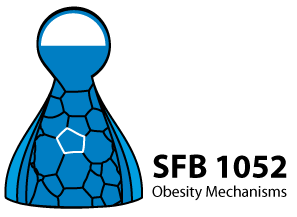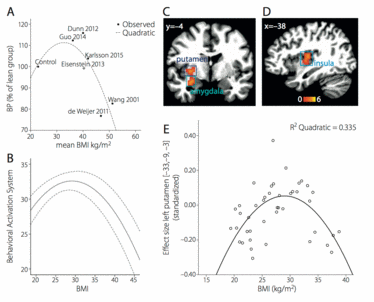A5 - Neurokognitive Modelle der Verhaltenskontrolle bei Adipositas - Die modulierenden Effekte von dynamischen Veränderungen im zentralen dopaminergen Tonus
Der Neurotransmitter Dopamin (DA) spielt eine zentrale Rolle in kognitiven Schlüsseldomänen wie Motivation, Verstärkungslernen und Gedächtnis. Unsere jüngsten Ergebnisse weisen auf (a) prominente Veränderungen in diesen Bereichen bei Probanden mit Übergewicht und Adipositas und (b) eine nicht-lineare Beziehung zwischen Adipositasmarkern und der zentralnervösen Übertragungseffizienz von Dopamin hin. Im Vergleich zu normalgewichtigen Probanden haben Individuen mit mäßiger Adipositas wahrscheinlich zu niedrige Dopamin-Spiegel, während stark adipöse Personen ein Übermaß an zentralem Dopamin aufweisen könnten. Dies hat für die Zuordnung zu experimentellen Gruppen wichtige Implikationen, da ein Pooling über mäßig und schwere Adipositas wahrscheinlich zu einem Null-finding führen wird. Weiterhin können unterschiedliche Effektrichtungen von neuronalen und Verhaltensänderungen in diesen Gruppen angenommen werden. Aufgrund ihrer zentralen Rolle haben Veränderungen in der dopaminergen Übertragung Auswirkungen auf sehr unterschiedliche Verhaltensweisen, wie z.B. Essverhalten, Entscheidungsfindung und Lernen. Darüber hinaus deuten umgekehrte Muster der Veränderung der dopaminergen Transmission auf ein differenziertes Muster kognitiver Veränderungen bei mäßig und schwer adipösen Probanden hin, was die Annahme separater Subpopulationen nahelegt. Interessant ist, dass mäßig und stark adipöse Menschen von entgegengesetzten Manipulationen der dopaminergen Übertragungseffizienz profitieren sollten. In Projekt A5 werden wir diese Vorhersagen experimentell testen. Speziell werden wir die Auswirkungen verschiedener pharmakologischer Manipulationen auf die zentrale dopaminerge Transmission bei mäßig und stark adipösen Probanden unter Verwendung von Verhaltenstests, funktioneller Magnetresonanztomographie (fMRI) und neurokognitiver Modellierung untersuchen, wobei letztere eine direkte Verknüpfung von Verhaltens- und neuralen Effekten auf individueller Ebene ermöglichen. Weiterhin werden wir die Wechselwirkung von natürlichen, d.h. genetischen Modulatoren der DA-Transmission mit Adipositas- und Diät-assoziierten Veränderungen in verschiedenen Hirnregionen untersuchen.
PD Dr. Jane Neumann, Integriertes Forschungs- und Behandlungszentrum AdipositasErkrankungen (Ko-Teilprojektleiterin 2013–2016)
Abbildung 1: (A) Quadratische Beziehung zwischen Positronenemissionstomographie (PET) Marker der dopaminergen Transmission und dem Body Mass Index (BMI). BP: Bindungspotenzial des PET-Tracers. (B) Umgekehrt U-förmige Beziehung zwischen Belohnungsempfindlichkeit und BMI. (C) Modulatorische Wirkung von BMI auf die Gehirnaktivität während der bewussten Regulierung des Verlangens nach Lebensmitteln. BMI ist nicht-linear mit der BOLD-Aktivierung in einem Cluster von linkem Putamen, Amygdala und Insula (D) assoziiert. (E) Umgekehrt u-förmige Beziehung zwischen BMI und BOLD Effektstärke im linken Putamen. (Farbkodierung bezieht sich auf t-Werte, p <.001 auf Voxel-Ebene, p <.05 Family Wise Error auf Cluster-Ebene Gesamthirn).
Poessel M, Breuer N, Joshi A, Pampel A, Villringer A, Hummel T, Horstman A. Reduced Olfactory Bulb Volume in Obesity and Its Relation to Metabolic Health Status. Front. Hum. Neurosci. 2020.
Hemispheric asymmetries in resting‐state EEG and fMRI are related to approach and avoidance behaviour, but not to eating behaviour or BMI. Hum Brain Mapp. 2020;41:1136-1152.
Poessel M, Freiherr J, Wiencke K, Villringer A, Horstmann A. Insulin Resistance Is Associated with Reduced Food Odor Sensitivity across a Wide Range of Body Weights. Nutrients. 2020 Jul 24;12(8):E2201.
Fürtjes S, King JA, Goeke C, Seidel M, Goschke T, Horstmann A, Ehrlich S. Automatic and Controlled Processing:Implications for Eating Behavior. Nutrients. 2020 Apr 15;12(4):1097.
Poessel M, Freiherr J, Horstmann A. Rapid assessment of olfactory sensitivity using the “Sniffin’ Sticks. Springer 2019.
Janssen LK, Mahner FP, Schlangenhauf F, Deserno L, Horstmann A. Reliance on model-based and model-free control in obesity. Jul 17,2019.
Morys F, Janssen LK, Cesnaite E, Beyer F, Garcia-Garcia I, Kube J, Kumral D, Liem F, Mehl N, Mahjoory K, Schrimpf A, Gaebler M, Margulies D, Villringer A, Neumann J, Nikulin V, Horstmann A. Hemispheric asymmetries in resting-state EEG and fMRI are related to approach and avoidance behaviour, but not to eating behaviour or BMI. Hum Brain Mapp. 2019 Nov 21.
García-García I, Kube J, Morys F, Schrimpf A, Kanaan AS, Gaebler M, Villringer A, Dagher A, Horstmann A, Neumann J. Liking and left amygdala activity during food versus non-food processing are modulated by emotional context. Cogn Affect Behav Neurosci. 2019 Nov 11.
Lammert, M., Morys, F., Hartmann, H., Janssen, L., & Horstmann, A. MIS – a new scoring method for the operation span task that accounts for math, remembered items and sequence. PsyArXiv.Aug2019
Fromm SP, Horstmann A., Psychometric Evaluation of the German Version of the Dietary Fat and Free Sugar-Short Questionnaire. Obes Facts. 2019;12(5):518-528.
Janssen LK, Herzog N, Waltmann M, Breuer N, Wiencke K, Rausch F, Hartmann H, Poessel M, Horstmann A. Lost in Translation? On the Need for Convergence in Animal and Human Studies on the Role of Dopamine in Diet-Induced Obesity. Curr Addict Rep (2019) 6: 229.
Fromm SP, Horstmann A., Psychometric Evaluation of the German Version of the Dietary Fat and Free Sugar-Short Questionnaire. Obes Facts. 2019;12(5):518-528.
Rohde K, Keller M, la Cour Poulsen L, Rønningen T, Stumvoll M, Tönjes A, Kovacs P, Horstmann A, Villringer A, Blüher M, Böttcher Y. (Epi)genetic regulation of CRTC1 in human eating behaviour and fat Distribution. EBioMedicine.2019Jun;44:476-488.
Meemken MT, Horstmann A. Appetitive Pavlovian-to-Instrumental Transfer in Participants with Normal-Weight and Obesity. Nutrients. 2019 May 9;11(5). pii: E1037.
Mehl N, Morys F, Villringer A, Horstmann A. Unhealthy yet Avoidable-How Cognitive Bias Modification Alters Behavioral and Brain Responses to Food Cues in Individuals with Obesity. Nutrients. 2019 Apr 18;11(4).
Babayan A, Erbey M, Kumral D, Reinelt JD, Reiter AMF, Röbbig J, Schaare HL, Uhlig M, Anwander A, Bazin PL, Horstmann A, Lampe L, Nikulin VV, Okon-Singer H, Preusser S, Pampel A, Rohr CS, Sacher J, Thöne-Otto A, Trapp S, Nierhaus T, Altmann D, Arelin K, Blöchl M, Bongartz E, Breig P, Cesnaite E, Chen S, Cozatl R, Czerwonatis S, Dambrauskaite G, Dreyer M, Enders J, Engelhardt M, Fischer MM, Forschack N, Golchert J, Golz L, Guran CA, Hedrich S, Hentschel N, Hoffmann DI, Huntenburg JM, Jost R, Kosatschek A, Kunzendorf S, Lammers H, Lauckner ME, Mahjoory K, Kanaan AS, Mendes N, Menger R, Morino E, Näthe K, Neubauer J, Noyan H, Oligschläger S, Panczyszyn-Trzewik P, Poehlchen D, Putzke N, Roski S, Schaller MC, Schieferbein A, Schlaak B, Schmidt R, Gorgolewski KJ, Schmidt HM, Schrimpf A, Stasch S, Voss M, Wiedemann A, Margulies DS, Gaebler M, Villringer A. A mind-brain-body dataset of MRI, EEG, cognition, emotion, and peripheral physiology in young and old adults. Sci Data. 2019 Feb 12;6:180308.
Meemken MT, Kube J, Wickner C, Horstmann A. Keeping track of promised rewards: Obesity predicts enhanced flexibility when learning from observation. Appetite. 2018 Dec 1;131:117-124.
Morys F, Bode S, Horstmann A. Dorsolateral and medial prefrontal cortex mediate the influence of incidental priming on economic decision making in obesity. Sci Rep. 2018 Dec 4;8(1):17595.
Hellrung L, Dietrich A, Hollmann M, Pleger B, Kalberlah C, Roggenhofer E, Villringer A, Horstmann A. Intermittent compared to continuous real-time fMRI neurofeedback boosts control over amygdala activation. Neuroimage. 2018 Feb 1;166:198-208.
Mehl N, Mueller-Wieland L, Mathar D, Horstmann A. Retraining automatic action tendencies in obesity. Physiol Behav. 2018 Mar 30. pii: S0031-9384(18)30154-9.
Hellrung L, Dietrich A, Hollmann M, Pleger B, Kalberlah C, Roggenhofer E, Villringer A, Horstmann A. Intermittent compared to continuous real-time fMRI neurofeedback boosts control over amygdala activation. NeuroImage. 2017;166:198-208.
Kube J, Mathar D, Horstmann A, Villringer A, Neumann J. Altered monetary loss processing and reinforcement-based learning in individuals with obesity. Brain Imaging Behav. 2017; in press.
Mathar D, Neumann J, Villringer A, Horstmann A. Failing to learn from negative prediction errors: Obesity is associated with alterations in a fundamental neural learning mechanism. Cortex.2017;95:222-37.
Mehl N, Bergmann S, Klein AM, Daum M, von Klitzing K, Horstmann A. Cause or consequence? Investigating attention bias and self-regulation skills in children at risk for obesity. J Exp Child Psychol. 2017;155:113-27.
Sjoerds Z, Dietrich A, Deserno L, de Wit S, Villringer A, Heinze HJ, Schlagenhauf F, Horstmann A. Slips of action and sequential decisions: A cross-validation study of tasks assessing habitual and goal-directed action control. Front Behav Neurosci. 2016;10:234.
Schrimpf A, Kube J, Neumann J, Horstmann A, Villringer A, Gaebler M. Parasympathetic cardio-regulation during social interactions in individuals with obesity - The influence of negative body image. Cogn Affect Behav Neurosci. 2017;17:330-47.
Dietrich A, de Wit S, Horstmann A. General Habit Propensity Relates to the Sensation Seeking Subdomain of Impulsivity But Not Obesity. Front Behav Neurosci. 2016;10:213.
Mathar D, Wilkinson L, Holl A,Neumann J, Deserno L, Villringer A, Jahanshahi M, Horstmann A. The role of dopamine in positive and negative prediction error utilization during incidental learning–insights from Positron Emission Tomography, Parkinson’s disease and Huntington’s disease. Cortex. 2016; Epub ahead of print.
Mühlberg C, Mathar D, Villringer A, Horstmann A, Neumann J. Stopping at the sight of food - How gender and obesity impact on response inhibition. Appetite. 2016;107:663-76.
Dietrich A, De Wit S, Horstmann A. General habit propensity relates to the sensation seeking subdomain of impulsivity but not obesity. Front Behav Neurosci. 2016;10:213.
Garcia-Garcia I, Kube J, Gaebler M, Horstmann A, Villringer A, Neumann J. Neural processing of negative emotional stimuli and the influence of age, sex and task-related characteristics. Neurosci Biobehav Rev. 2016;68:773-93.
Masouleh SK, Arélin K, Horstmann A, Lampe L, Kipping JA, Luck T, Riedel-Heller SG, Schroeter ML, Stumvoll M, Villringer A, Witte AV. Higher body mass index in older adults is associated with lower gray matter volume: implications for memory performance. Neurobiol Aging. 2016;40:1-10.
Grellmann C, Neumann J, Bitzer S, Kovacs P, Tönjes A, Westlye LT, Anreassen OA, Stumvoll M, Villringer A, Horstmann A. Random projection for fast and efficient multivariate correlation analysis of high-dimensional data: A new approach. Front Genet. 2016;7:102.
Dietrich A, Hollmann M, Mathar D, Villringer A, Horstmann A. Brain regulation of food craving: Relationships with weight status & eating behavior. Int J Obes (Lond). 2016;40:982-9.
Kube J, Schrimpf A, Garcia-Garcia I, Villringer A, Neumann J, Horstmann A. Differential heart rate responses to social and monetary reinforcement in women with obesity. Psychophysiology. 2016;53:868-79.
Schlögl H, Horstmann A, Villringer A, Stumvoll M. Functional neuroimaging in obesity and the potential for development of novel treatments. Lancet Diabetes Endocrinol. 2016;4:695-705.
Mathar D, Horstmann A, Pleger B, Villringer A, Neumann J. Is it worth the effort? Novel insights into obesity-associated alterations ins cost-benefit decision-making. Front Behav Neurosci. 2016;9:360.
Simmank J, Murawski C, Bode S, Horstmann A. Incidental rewarding cues influence economic decisions in people with obesity. Front Behav Neurosci. 2015;9:278.
Deserno L, Wilbertz T, Reiter A, Horstmann A, Neumann J, Villringer A, Heinze HJ, Schlagenhauf F. Lateral prefrontal model-based signatures are reduced in individuals with high trait impulsivity. Transl Psychiatry. 2015;5:e659.
Löffler A, Luck T, Then FS, Sikorski C, Kovacs P, Böttcher Y, Breitfeld J, Tönjes A, Horstmann A, Löffler M, Engel C, Thiery J, Villringer A, Stumvoll M, Riedel-Heller SG. Eating Behaviour in the General Population: An Analysis of the Factor Structure of the German Version of the Three-Factor-Eating-Questionnaire (TFEQ) and Its Association with the Body Mass Index. PLoS One. 2015;10:e0133977.
Garcia-Garcia I, Jurado MA, Garolera M, Marques-Iturria I, Horstmann A, Segura B, Pueyo R, Sender-Palacios MJ, Vernet-Vernet M, Villringer A, Junque C, Margulies DS, Neumann J. Functional network centrality in obesity: A resting-state and task fMRI study. Psychiatry Res. 2015;233:3331-8.
Mueller K, Möller HE, Horstmann A, Busse-Voigt FP, Lepsien J, Blüher M, Stumvoll M, Villringer A, Pleger B. Physical exercise in overweight to obese individuals induces metabolic- and neurotrophic-related structural brain plasticity. Front Hum Neurosci. 2015;9:372.
Horstmann A, Fenske WK, Hankir MK. Argument for a non-linear relationship between severity of human obesity and dopaminergic tone. Obes Rev. 2015;16:821-30.
Löffler A, Luck T, Then FS, Luppa M, Sikorski C, Kovacs P, Tönjes A, Böttcher Y, Breitfeld J, Horstmann A, Löffler M, Engel C, Thiery J, Stumvoll M, Riedel-Heller SG. Age- and gender-specific norms for the German version of the Three-Factor Eating-Questionnaire (TFEQ). Appetite. 2015;91:241-7.
Hankir MK, Ashrafian H, Hesse S, Horstmann A, Fenske WK. Distinctive striatal dopamine signaling after dieting and gastric bypass. Trends Endocrinol Metab. 2015;26:223-30.
Rohde K, Federbusch M, Horstmann A, Keller M, Villringer A, Stumvoll M, Tönjes A, Kovacs P, Böttcher Y. Genetic variants in AKR1B10 associate with human eating behavior. BMC Genet. 2015;16:31.
Hellrung L, Hollmann M, Zscheyge O, Schlumm T, Kalberlah C, Roggenhofer E, Okon-Singer H, Villringer A, Horstmann A. Flexible adaptive paradigms for fMRI using a novel software package 'Brain Analysis in Real-Time' (BART). PLoS One. 2015;10:e0118890.
Rohde K, Keller M, Horstmann A, Liu X, Eichelmann F, Stumvoll M, Villringer A, Kovacs P, Tönjes A, Böttcher Y. Role of genetic variants in ADIPOQ in human eating behavior. Genes Nutr. 2015;10:449.
Grellmann C, Bitzer S, Neumann J, Westlye LT, Andreassen OA, Villringer A, Horstmann A. Comparison of variants of canonical correlation analysis and partial least squares for combined analysis of MRI and genetic data. Neuroimage. 2015;107:289-310.
Mueller K*, Horstmann A*, Möller HE, Anwander A, Lepsien J, Schroeter ML, Villringer A, Pleger B. Obesity associated cerebral gray and white matter alterations are interrelated in the female brain. PLoS One. 2014;9:e114206.
Horstmann A, Dietrich A, Mathar D, Pössel M, Villringer A, Neumann J. Slave to habit? Obesity is associated with decreased behavioural sensitivity to reward devaluation. Appetite. 2014;87C:175-83.
Dietrich A*, Federbusch MG*, Grellmann C, Villringer A, Horstmann A. Body weight status, eating behavior, sensitivity to reward/punishment, and geder: relationships and interdependencies. Front Psychol. 2014;5:1073.
Garcia-Garcia I, Horstmann A, Jurado MA, Garolera M, Chaudhry SJ, Margulies DS, Villringer A, Neumann J. Reward processing in obesity, substance addiction and non-substance addiction. Obes Rev. 2014;15:853-69.
Wilbertz T, Deserno L, Horstmann A, Neumann J, Villringer A, Heinze HJ, Boehler CN, Schlagenhauf F. Response inhibition and its relation to multidimensional impulsivity. Neuroimage. 2014;103:241-8.
Gast MT, Tönjes A, Keller M, Horstmann A, Steinle N, Scholz M, Müller I, Villringer A, Stumvoll M, Kovacs P, Böttcher Y. The role of rs2237781 within GRM8 in eating behavior. Brain Behav. 2013;3:495-502.
Machann J, Horstmann A, Born M, Hesse S, Hirsch FW. Diagnostic imaging in obesity. Best Pract Res Clin Endocrinol Metab. 2013;27:261-77.
Horstmann A, Kovacs P, Kabisch S, Boettcher Y, Schloegl H, Toenjes A, Stumvoll M, Pleger B, Villringer A. Common genetic variation near MC4R has a sex-specific impact on human brain structure and brain behavior. PLoS One. 2013;8:e74362.
Schloegl H*, Kabisch S*, Horstmann A, Lohmann G, Mueller K, Lepsien J, Busse-Voigt FP, Kratzsch J, Pleger B, Villringer A, Stumvoll M. Exenatide-induced reduction in energy intake is associated with increase in hypothalamic connectivity. Diabetes Care. 2013;36:1933-40.
Hollmann M, Pleger B, Villringer A, Horstmann A. Brain imaging in the context of food perception and eating. Curr Opin Lipidol. 2013;24:18-24.
Steingroever H, Wetzels R,Horstmann A, Neumann J, Wagenmakers EJ. Performance of Healthy Participants on the Iowa Gambling Task. Psychol Assess. 2012;25:180-93.
Horstmann A, Villringer A,Neumann J. Iowa Gambling Task: There is More to Consider than Long-Term Outcome. Using a Linear Equation Model to Disentangle the Impact of Outcome and Frequency of Gains and Losses. Front Neurosci. 2012;6:61.
Hollmann M, Hellrung L, Pleger B, Schlögl H, Kabisch S, Stumvoll M, Vill ringer A,Horstmann A. Neural correlates of the volitional regulation of the desire food. Int J Obes (Lond). 2012;36:648-55.
Horstmann A, Busse FP, Mathar D, Müller K, Lepsien J, Schlögl H, Kabisch S, Kratzsch J,Neumann J, Stumvoll M, Villringer A, Pleger B. Obesity-Related Differences between Women and Men in Brain Structure and Goal-Directed Behavior.Front Hum Neurosci. 2011;5:58.
Müller K, Anwander A, Möller HE, Horstmann A, Lepsien J, Busse F, Mohammadi S, Schroeter ML, Stumvoll M, Villringer A, Pleger B. Sex-dependent influences of obesity on cerebral white matter investigated by diffusion-tensor imaging.PLoS One. 2011;6:e18544.
Schlögl H, Percik R,Horstmann A, Villringer A, Stum voll M. Peptide hormones regulating appetite - focus on neuroimaging studies in humans. Diabetes Metab Res Rev. 2011;27:104-12.
Lizier JT, Heinzle J, Horstmann A, Haynes JD, Prokopenko M. Multivariate information-theoretic measures reveal directed information structure and task relevant changes in fMRI connectivity. J Comput Neurosci. 2011;30:85-107.
Taubert M, Draganski B, Anwander A, Müller K, Horstmann A, Villringer A, Ragert P. Dynamic properties of human brain structure: learning-related changes in cortical areas and associated fiber connections. J Neurosci. 2010;30:11670-7.
Lohmann G, Margulies DS, Horstmann A, Pleger B, Lepsien J, Goldhahn D, Schloegl H, Stumvoll M, Villringer A, Turner R. Eigenvector centrality mapping for analyzing connectivity patterns in fMRI data of the human brain. PLoS One. 2010;5:e10232.



